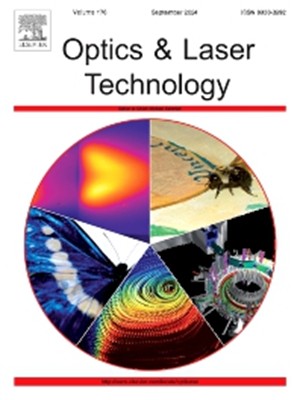Influence of feedback phase on time delay signature and chaos bandwidth in a laser subject to dual optical feedback
IF 4.6
2区 物理与天体物理
Q1 OPTICS
引用次数: 0
Abstract
Semiconductor lasers subject to optical feedback can behave chaotically, which can be used as a source of randomness. The optical feedback, provided by mirrors at a distance, determines the characteristics of the chaos and thus the quality of the randomness. However, this fixed distance also shows itself in the intensity, an unwanted feature called the Time Delay Signature (TDS). One promising solution to suppress the TDS is using double optical feedback. We study this system numerically in this paper. In particular, we focus on the impact of the feedback phase, a sub-wavelength change in the position of the mirrors, on the TDS and chaos bandwidth (CBW) of the system. We show that by precisely setting the feedback parameters, including the feedback phases, the TDS can be suppressed, and that the feedback phase control is necessary rather than optional to robustly suppress the TDS. In addition, it is possible to suppress the TDS without loss of the CBW. At strong feedback rates the system can restabilize, and one can switch between a chaotic and steady state by changing only the feedback phase. Finally, we relate the feedback phase sensitivity to interference between the two delayed signals. This system is promising for applications of chaotic lasers as one can either suppress the TDS or increase the CBW.
求助全文
约1分钟内获得全文
求助全文
来源期刊
CiteScore
8.50
自引率
10.00%
发文量
1060
审稿时长
3.4 months
期刊介绍:
Optics & Laser Technology aims to provide a vehicle for the publication of a broad range of high quality research and review papers in those fields of scientific and engineering research appertaining to the development and application of the technology of optics and lasers. Papers describing original work in these areas are submitted to rigorous refereeing prior to acceptance for publication.
The scope of Optics & Laser Technology encompasses, but is not restricted to, the following areas:
•development in all types of lasers
•developments in optoelectronic devices and photonics
•developments in new photonics and optical concepts
•developments in conventional optics, optical instruments and components
•techniques of optical metrology, including interferometry and optical fibre sensors
•LIDAR and other non-contact optical measurement techniques, including optical methods in heat and fluid flow
•applications of lasers to materials processing, optical NDT display (including holography) and optical communication
•research and development in the field of laser safety including studies of hazards resulting from the applications of lasers (laser safety, hazards of laser fume)
•developments in optical computing and optical information processing
•developments in new optical materials
•developments in new optical characterization methods and techniques
•developments in quantum optics
•developments in light assisted micro and nanofabrication methods and techniques
•developments in nanophotonics and biophotonics
•developments in imaging processing and systems

 求助内容:
求助内容: 应助结果提醒方式:
应助结果提醒方式:


